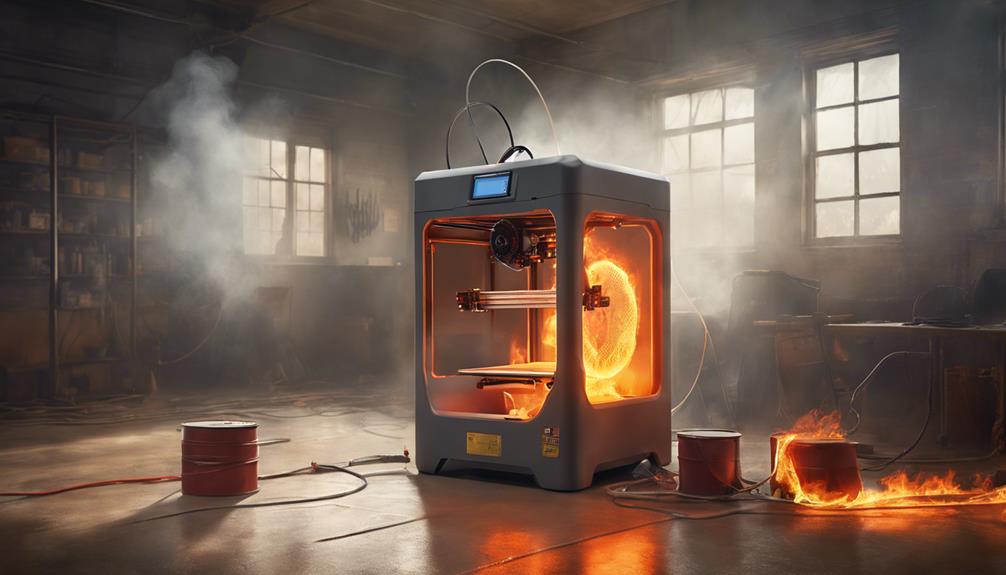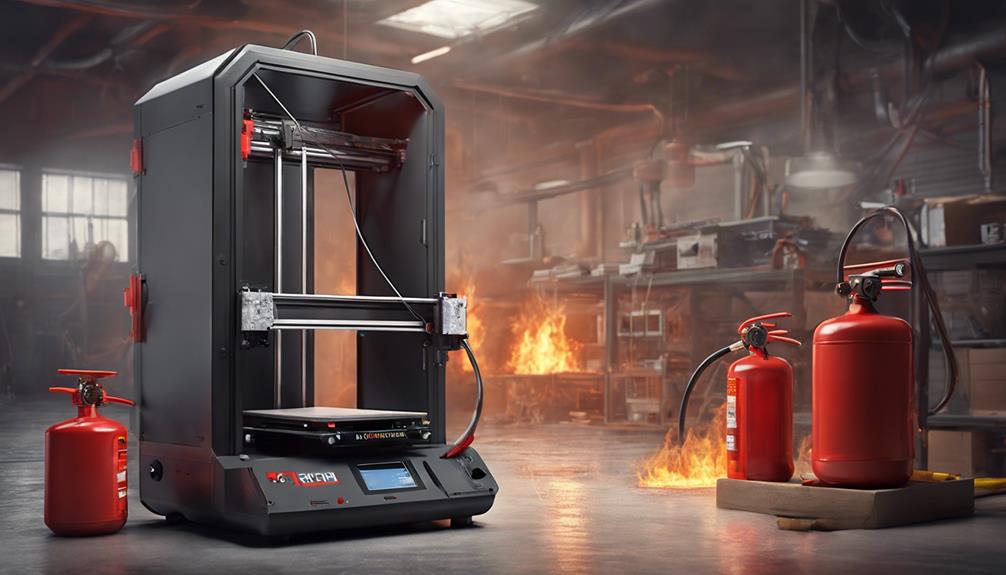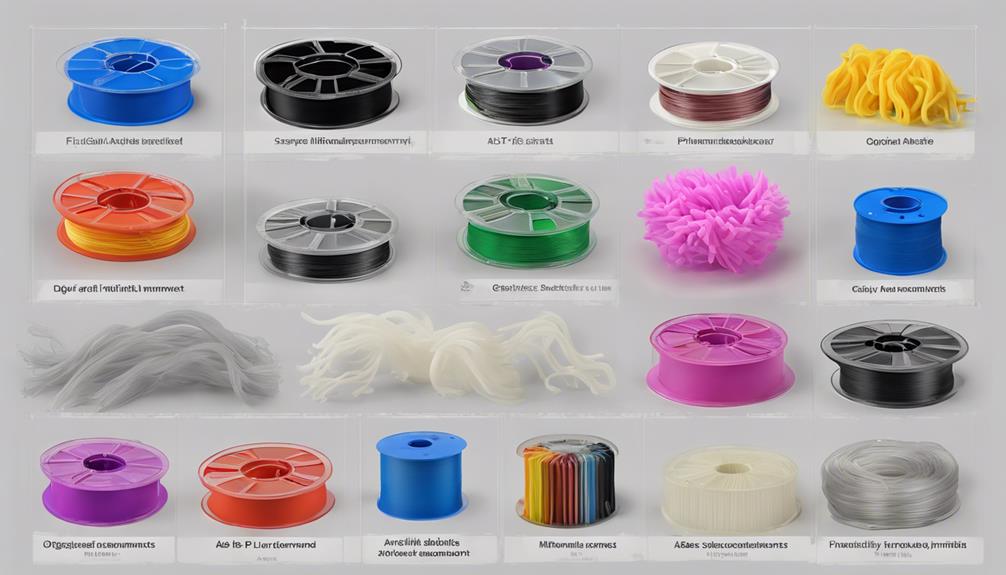Understanding the flammability characteristics of various 3D printing filaments is crucial for maintaining a safe workspace and preventing potential hazards. From the highly flammable nature of PLA and ABS filaments to the safer alternatives like PETG, each material presents unique risks that require careful handling and precautionary measures. By exploring the nuanced nuances of these filaments and following the recommended safety protocols, users can greatly reduce the likelihood of accidents and guarantee a secure printing environment.
Flammability of PLA Filament

The flammability of PLA filament poses significant safety concerns due to its propensity to ignite easily at low temperatures. PLA, being the most commonly used 3D printing filament, has a high flammability rate, making it prone to catching fire quickly.
This plastic substitute, derived from fermented plant starch, burns at lower temperatures compared to other filaments. When burned, PLA releases volatile organic compounds (VOCs) that, if inhaled, can lead to health issues such as asthma.
It is important to take safety precautions before burning PLA to minimize the risks associated with its flammability. Industrial applications of PLA are limited due to these safety concerns, highlighting the importance of proper handling and storage practices with this filament.
Risks of ABS Filament
What potential hazards are associated with the use of ABS filament in 3D printing applications?
ABS filament poses several risks due to its flammability and the production of harmful gases when exposed to high temperatures. Here are some key risks to be aware of:
- ABS is flammable and can catch fire easily.
- When exposed to common wood fire temperatures, ABS can ignite.
- Melting ABS at around 210°C produces flammable fumes.
- Combustion of ABS releases toxic gases like carbon monoxide and hydrogen cyanide.
It is important to implement safety measures when handling ABS filament to mitigate these risks effectively.
Safety With PETG Filament

Discussing the safety considerations when utilizing PETG filament in 3D printing applications is paramount due to its higher resistance to flames compared to other commonly used filaments. PETG filament is known for its enhanced flame resistance, making it a vital option for various printing projects. However, it is still important to follow safety guidelines to minimize any potential risks.
Proper handling and storage practices can further reduce fire hazards associated with PETG. By maintaining a clean workspace, ensuring adequate ventilation, and implementing safe printing practices, users can enjoy the benefits of PETG filament while prioritizing safety. It is essential to be diligent and cautious when working with any type of filament to prevent accidents and ensure a secure printing environment.
Fire Risks With TPU Filament
Fire risks associated with TPU filament can be mitigated through proper handling and storage practices.
- Avoiding High Temperatures: TPU filament should be kept away from sources of heat.
- Ventilation: Ensuring good ventilation in the printing area can reduce the risk of ignition.
- Fire Safety Equipment: Having fire extinguishers nearby can help in case of emergencies.
- Regular Maintenance: Checking 3D printers regularly for any signs of wear or malfunction can prevent potential fire hazards.
Choosing 3D Printing Products

When selecting 3D printing products, it is crucial to prioritize functionality, reliability, and compatibility with your specific printing needs. Consider the type of projects you intend to undertake and make sure that the chosen products can meet those requirements effectively. Look for printers that offer the desired level of precision and speed, along with a reputation for durability.
When it comes to filaments, opt for tested and reliable options to achieve consistent results. Upgrades should enhance the performance of your equipment without compromising safety. By focusing on these aspects, you can streamline your decision-making process and guarantee that the selected products align with your 3D printing goals.
Author's 3D Printing Background
Martin Mayer, with a deep-rooted passion for 3D printing since 2013, has continually embraced the evolving technology landscape.
- Started with an FDM printer in 2013.
- Actively engages with the 3D printing community.
- Regularly updates knowledge on the latest trends.
- Contributes to the community through articles and tools.
Martin's journey showcases a profound dedication to exploring the capabilities of 3D printing technology, from its beginnings to its current advancements. His involvement in the community and commitment to staying informed allow him to provide valuable insights and recommendations regarding the risks and benefits associated with various filaments.
Engaging in the Comment Section

Initiating interaction within the comment section fosters a thorough exchange of ideas and perspectives among readers and the author. Engaging in the comment section provides an opportunity for readers to share their insights, ask questions, and offer additional information related to the article's content.
It allows for a more in-depth exploration of the topic, potentially leading to a deeper understanding for all involved. By participating in the comment section, readers can contribute valuable perspectives, challenge assumptions, and enhance the overall discourse surrounding the subject matter.
Active engagement in the comment section not only enriches the reading experience but also creates a collaborative environment where knowledge and opinions can be shared and discussed constructively.
Frequently Asked Questions
Are There Any Health Risks Associated With Burning PLA Filament?
When burning PLA filament, health risks emerge from inhaling volatile organic compounds (VOCs), known to trigger respiratory issues like asthma. Proper safety measures are essential during combustion to mitigate exposure to harmful fumes and safeguard health.
What Are the Dangers of Inhaling Fumes From Burning ABS Filament?
Inhaling fumes from burning ABS filament can release harmful gases like carbon monoxide and hydrogen cyanide. These toxins pose serious health risks, emphasizing the importance of proper ventilation and safety protocols when working with ABS filaments.
How Can Proper Handling Reduce Fire Risks When Using PETG Filament?
Proper handling of PETG filament reduces fire risks by ensuring adherence to recommended storage conditions, avoiding exposure to high temperatures, and implementing safe printing practices. These precautions mitigate the flammability of PETG and promote a secure 3D printing environment.
What Precautions Should Be Taken to Minimize Fire Hazards With TPU Filament?
Precautions to minimize fire hazards with TPU filament include proper storage and handling practices. TPU's lower flammability than PLA and ABS necessitates caution. Adhering to safety protocols and avoiding exposure to high temperatures can greatly reduce the risk of fire incidents.
How Can I Ensure the 3D Printing Products I Choose Are Reliable and Suitable?
Ensuring reliability and suitability of 3D printing products involves meticulous research, considering factors like user expertise and intended applications. Selecting reputable brands, reading reviews, and seeking expert advice are prudent steps towards making informed decisions.
Conclusion
In summary, comprehending the flammability risks associated with different 3D printing filaments is vital for maintaining a safe printing environment.
By following safety recommendations and choosing appropriate products, users can minimize the potential dangers of PLA, ABS, PETG, and TPU filaments.
It is important to prioritize safety measures such as proper ventilation, fire extinguisher accessibility, and regular equipment maintenance to guarantee safe and effective 3D printing practices.